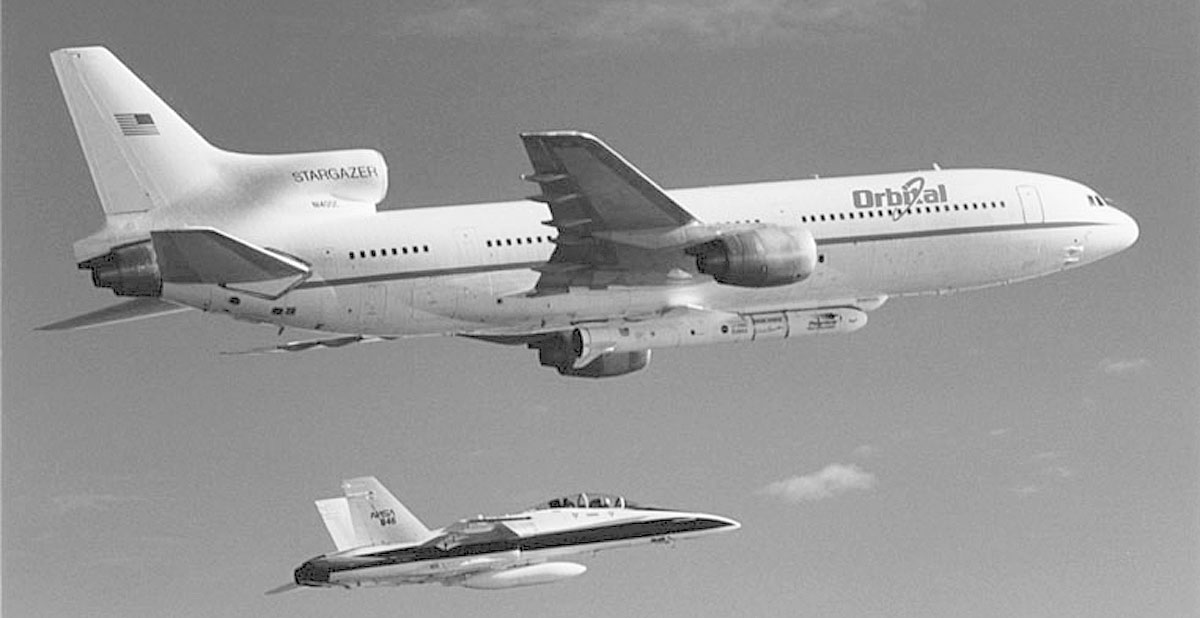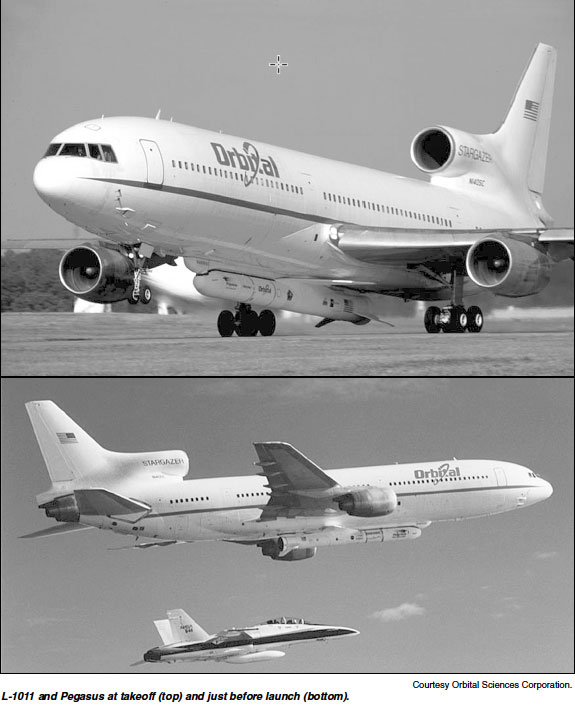Pegasus
NOTE: AIAA only page editing

L-1011 and Pegasus at takeoff

Just before launch
About Orbital Sciences Corporation
Pegasus Vehicle Description
General Description

National Origin
United StatesMain Organization
Summary
Flight Rate
Estimated Launch Price
$15–25 million (OSC, 2002)
Spaceports
Pegasus can operate from a number of established airfields and ranges. In addition to the sites listed, Pegasus has operated from Edwards AFB, California, and from Gando AFB, Canary Islands. Other sites such as Kodiak Island, Alaska, and Alcântara, Brazil, are options for future missions. Please refer to the Spaceports chapter for information on these sites. Pegasus is released from its carrier aircraft over the ocean. The coordinates of sites listed below reflect the location of the airfield used for takeoff, not the point of release of the launch vehicle.
| Launch site | Vandenberg AFB |
| Location | 34.7° N, 120.6° E |
| Available Inclinations | 70–130 deg |
| Launch site | Wallops Flight Facility |
| Location | 37.9° N, 75.4° W |
| Available Inclinations | 30–65 deg |
| Launch site | Cape Canaveral Air Force Station |
| Location | 28.5° N, 81.0° W |
| Available Inclinations | 28–58 deg |
| Launch site | Reagan Test Site (Kwajalein, Marshall Islands) |
| Location | 8.5° N, 167.7° W |
| Available Inclinations | 11–18 deg, equatorial inclinations achieved with dogleg maneuver |
Launch Operations
Pegasus was designed to simplify and minimize field integration personnel, facilities, and equipment. The build up of Pegasus begins with the delivery of the SRM sections to the integration site at Vandenberg AFB, California. Motors are shipped in standard ordnance transportation vans (TARVANs) on custom-designed handling dollies. The motor sections remain on these handling dollies throughout the integration process, which eliminates the need for lifting motors in the field. Upon arrival, stages are removed from the TARVANs and placed on a custom designed multifunction assembly and integration trailer (AIT). The AIT has integral lifting jacks that allow it to be elevated to TARVAN bed height so the motor sections can be offloaded directly onto the AIT bed. The AIT is then lowered to floor level for motor offloading to one of the four vehicle integration rails. The avionics subsystem is delivered to the field completely integrated, acceptance-tested, and ready for integration with the third-stage motor. The wing, fins, and payload fairing are received with all thermal protection and instrumentation installed. Once the vehicle has been integrated and tested, the payload is mated and the fairing installed. The rocket is transferred back to the AIT, and the AIT is used to transport Pegasus to the carrier aircraft, elevate it, and align it for mating. The combined AIT and custom dolly system provides full six-degree-of-freedom movement capability for the finished vehicle. A portable air conditioning unit provides filtered, dehumidified air for the payload and avionics during transport. Once the rocket arrives at the airfield, a ground air conditioner provides thermally conditioned clean air until this function is transferred to the airborne air condition system on the carrier aircraft, which provides environmental control until drop. No launch pad is required for Pegasus, only a runway capable of accommodating wide-body aircraft. Pegasus missions are launched from a modified L-1011 aircraft named Stargazer. Early government-sponsored launches were carried aloft by the NASA-owned B-52 aircraft that supported air drops of the X-15, X-24, X-38, and other experimental aircraft. Using an aircraft instead of a fixed launch complex reduces infrastructure costs. In addition, because launch is initiated well offshore, range safety requirements and associated concerns are reduced compared to typical launch sites. Launch begins with the release of Pegasus from the carrier aircraft at approximately 11.9 km (39,000 ft) altitude and 0.8 Mach. First-stage ignition occurs 5 s after release from the carrier aircraft, after Pegasus has dropped approximately 90 m (300 ft). Pegasus launch vehicles are assembled at VAFB, and the “standard mission” includes payload integration and launch from VAFB. In a “ferry mission” the spacecraft is integrated at VAFB, and then flown by the carrier aircraft to another launch site, such as CCAFS, for launch. In a “campaign mission” only the Pegasus is assembled at VAFB, and the spacecraft integration process is conducted at the alternate launch site. This gives Pegasus a significant degree of flexibility to adapt to customer needs and to reach a wider varietry of orbital inclinations. Launches have been conducted from four locations in the United States, plus the Canary Islands, and Kwajelein atoll in the Pacific. The Alcântara launch facility in Brazil is also available for future launches. If the selected launch location does not have tracking, control, and communications systems in place, deployable assets such as the NASA Wallops Mobile Range equipment can be used. Locations of Pegasus launch sites are shown below.
Primary Missions
Small commercial and government LEO payloads
Status
Key Organizations
Marketing Organization
Launch Service Provider
Prime Contractor
Performance
The performance for the Pegasus launch vehicle with a 965-mm (38-in.) marmon clamp interface is shown below.
| Available Inclinations: | 0–180 deg |
| 185 km (100 nm), 28.5 deg | 443 kg (977 lbm) |
| 185 km (100 nm), 90 deg | 332 kg (732 lbm) |
| Space Station Orbit: 407 km (220 nm), 51.6 deg | 361 kg (796 lbm) |
| Sun-Synchronous Orbit: 800 km (432 nm), 98.6 deg | 190 kg (420 lbm) |
Pegasus missions begin when the Orbital carrier aircraft (OCA) releases the Pegasus booster at an altitude of approximately 12 km (39,000 ft) and a speed of Mach 0.8. The added initial velocity and lower drag of an air launch allow Pegasus to be smaller than a booster of equivalent capability launched from the ground. In addition, the air launch capability means Pegasus can be launched from any ocean area with suitable tracking facilities, and therefore it can reach almost any orbit inclination. In a typical mission, the first-stage booster ignites 5 s after release from the aircraft and quickly initiates a pull-up maneuver to gain altitude. The vehicle decreases its pitch angle about 25 s into flight, and the second-stage ignition occurs shortly after the first stage burns out. There is a long coast period before third-stage ignition to allow the vehicle to reach orbital altitude, and then the third stage provides the remaining velocity to achieve orbit. Because solid motors have relatively large uncertainties in performance, Pegasus trajectories are designed with an additional velocity margin in the form of a flight performance reserve. If motor performance is less than nominal, the velocity margin ensures sufficient performance to reach the target orbit. If motor performance meets or exceeds nominal levels, the additional velocity can be eliminated by steering out of plane, or it can be used to maximize the orbit altitude. Orbital offers a small hydrazine-fueled fourth stage called the hydrazine auxiliary propulsion system (HAPS) located inside the avionics section for minimal impact on available payload volume. Missions using the HAPS stage can achieve higher performance at high altitude and also have improved orbit injection accuracy.


